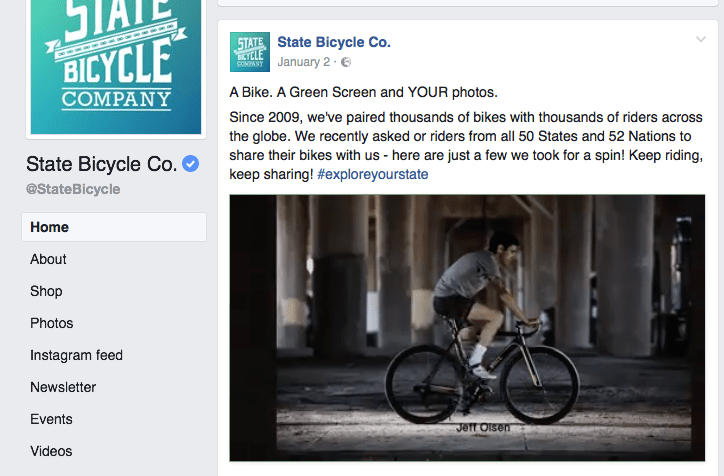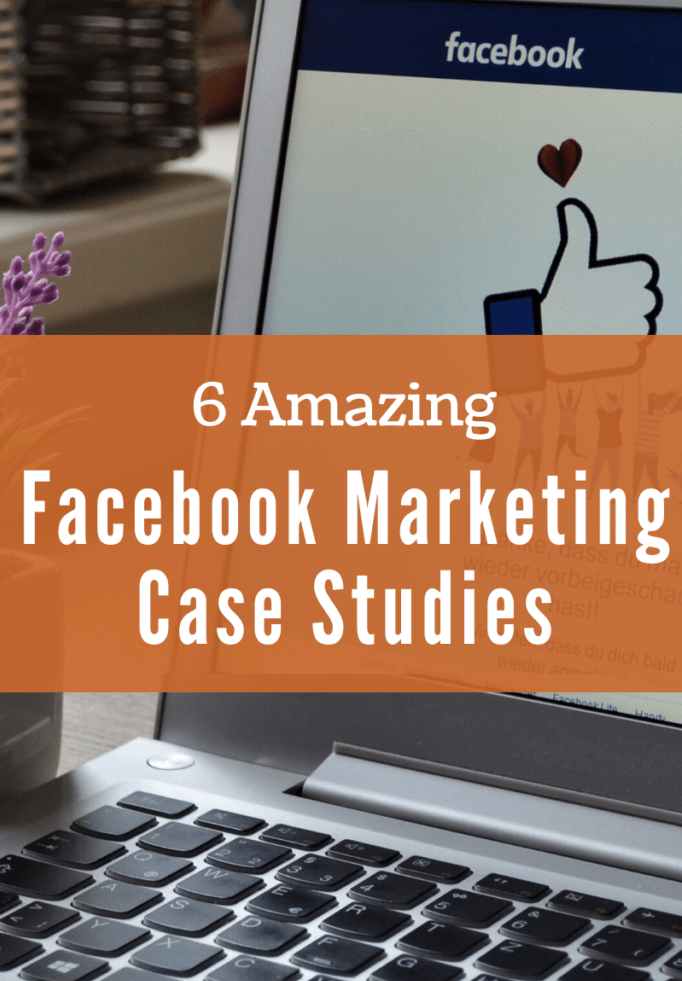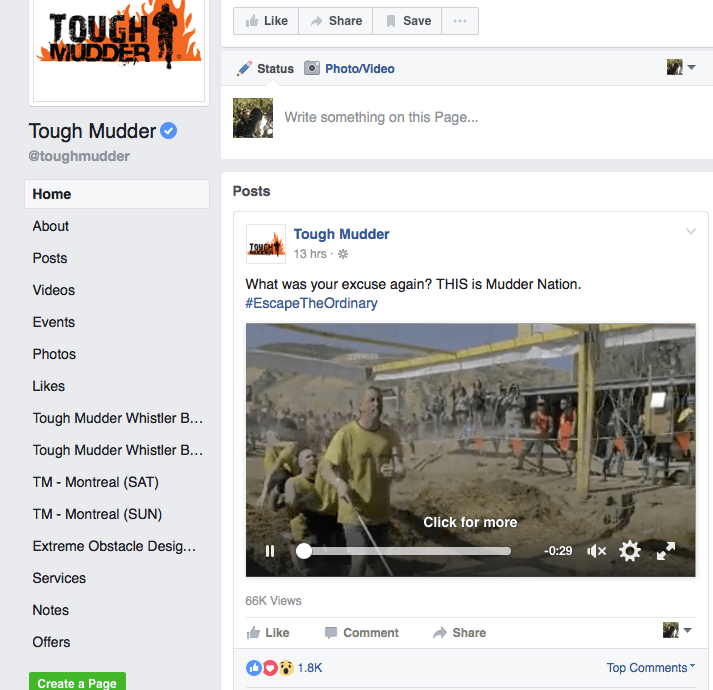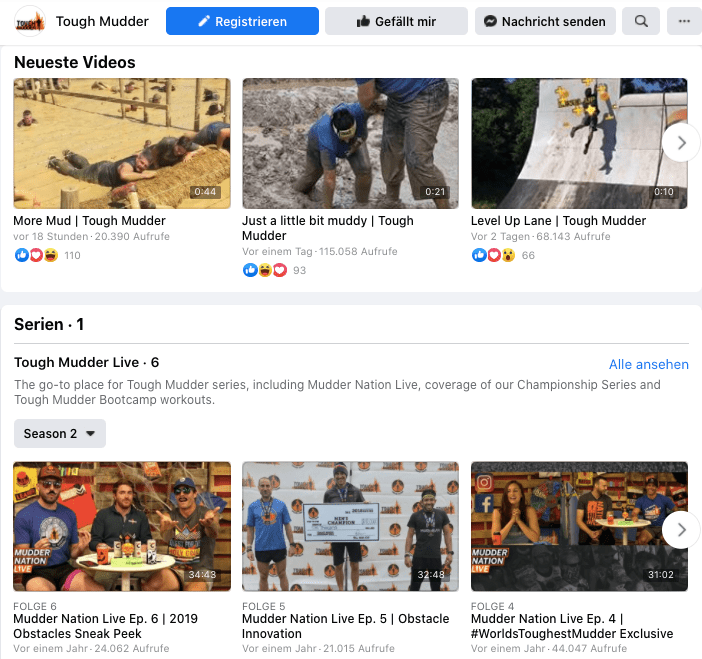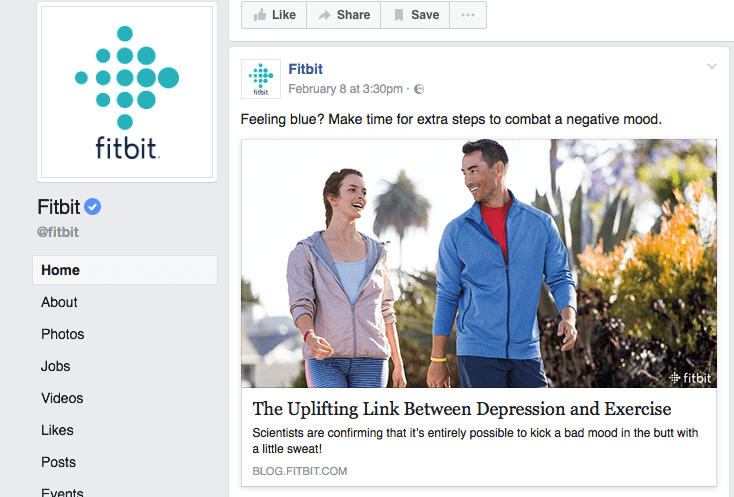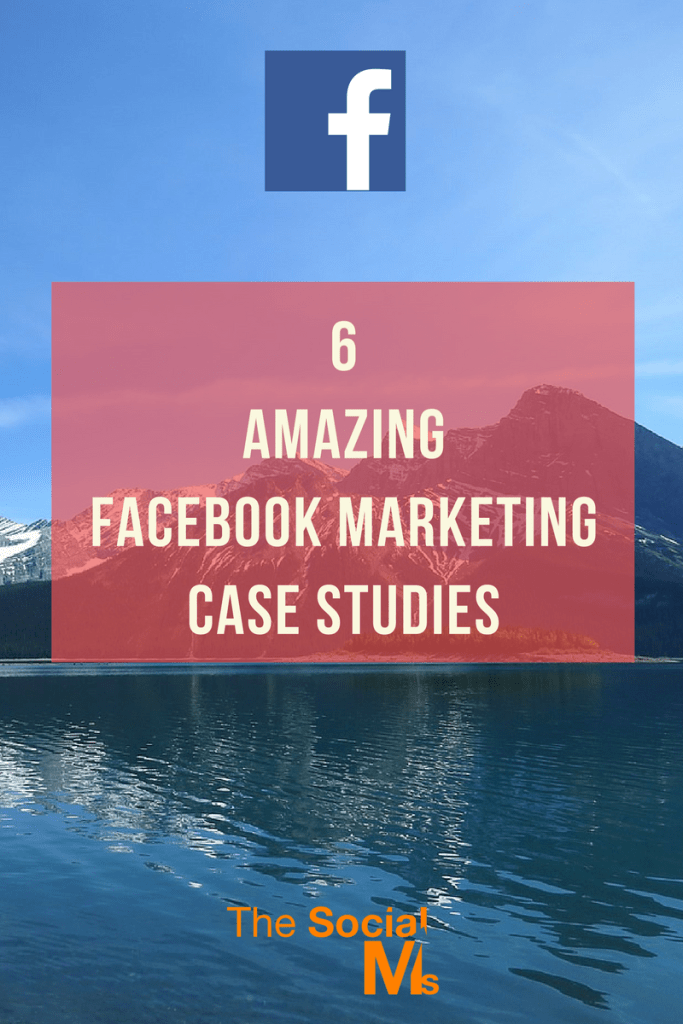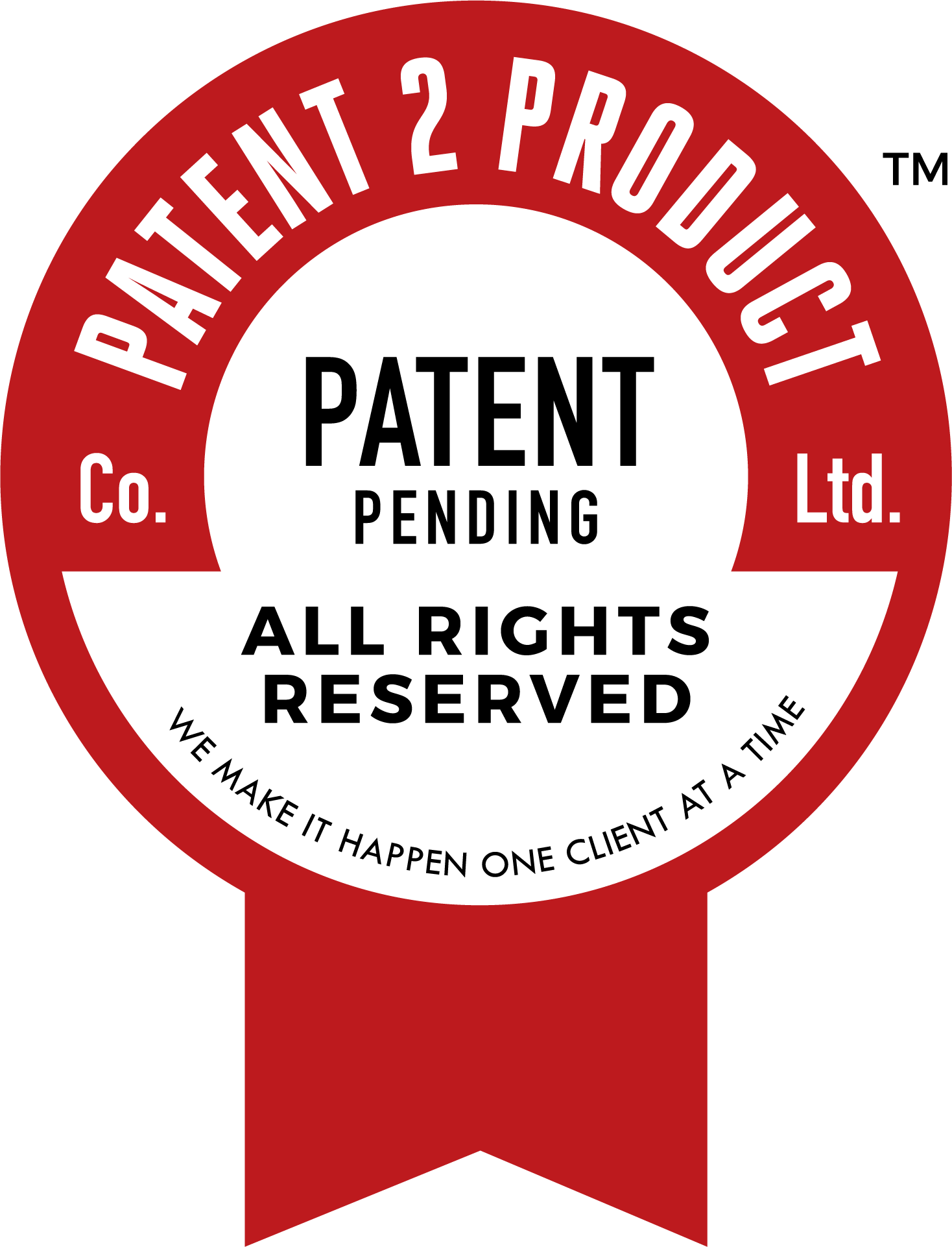
Although Facebook is one of the older social media networks, it’s still a thriving platform for businesses who want to boost brand awareness.
With over 2.38 billion monthly active users, you can use the platform to spread the word about your business in a number of different ways — from photos or videos to paid advertisements.
Because there are so many marketing options and opportunities on Facebook, It can be hard to tell which strategy is actually best for your brand.
If you’re not sure where to start, you can read case studies to learn about strategies that marketing pros and similar businesses have tried in the past.
A case study will often go over a brand’s marketing challenge, goals, a campaign’s key details, and its results. This gives you a real-life glimpse at what led a marketing team to reach success on Facebook. Case studies also can help you avoid or navigate common challenges that other companies faced when implementing a new Facebook strategy.
To help you in choosing your next Facebook strategy, we’ve compiled a list of 11 great case studies that show how a number of different companies have succeeded on the platform.
Even if your company has a lower budget or sells a different product, we hope these case studies will inspire you and give you creative ideas for your own scalable Facebook strategy.
Download our complete guide to using Facebook for business and marketing for free here.
Facebook Brand Awareness Case Studies:
Pandora
During the 2017 holiday season, the jewelry company Pandora wanted to boost brand awareness in the German market. They also wanted to see if video ads could have the same success as their other Facebook ad formats.
They began this experiment by working with Facebook to adapt a successful TV commercial for the platform. Here’s a look at the original commercial:
The ad was cut down to a 15-second clip which shows a woman receiving a Pandora necklace from her partner. It was also cropped into a square size for mobile users. Pandora then ran the ad targeting German audiences between the ages of 18-50. It appeared in newsfeeds and as an in-stream video ad.
Results: According to the case study, the video campaign lifted brand sentiment during the holiday season, with a 10-point lift in favorability. While Pandora or the case study didn’t disclose how they measured their favorability score, they note that the lift means that more consumers favored Pandora over other jewelers because of the ad.
Financially, the campaign also provided ROI with a 61% lift in purchases and a 42% increase in new buyers.
Takeaways
Video can be memorable, emotional, and persuasive. While the case study notes that Pandora always had success with ads and purchases, the jeweler saw that a video format could boost brand awareness even further.
In just 15 seconds, Pandora was able to tell a short story that their target audience could identify with while also showing off their product. The increase in favorability shows that audiences who saw the ad connected with it and preferred the jeweler over other companies because of the marketing technique.
Part of Pandora’s success might also be due to the video’s platform adaptation. Although they didn’t create a specific video for the Facebook platform, they picked a commercial that had already resonated with TV audiences and tweaked it to grab attention of fast-paced Facebook users. This is a good example of how a company can be resourceful with the content it already has while still catering to their online audiences.
The Rock & Roll Hall of Fame, a HubSpot customer, wanted to boost brand awareness and get more ticket purchases to their museum. Since they’d mainly used traditional customer outreach strategies in the past, they wanted to experiment with more ways of reaching audiences on social media.
Because the museum’s social media team recognized how often they personally used Facebook Messenger, they decided to implement a messaging strategy on the Hall of Fame’s official business page.
From the business page, users can click the Get Started button and open a chat with the Hall of Fame. Through the chat, social media managers were able to quickly reply to questions or comments from fans, followers, and prospective visitors. The reps would also send helpful links detailing venue pricing, events, other promotions, and activities in the surrounding area.
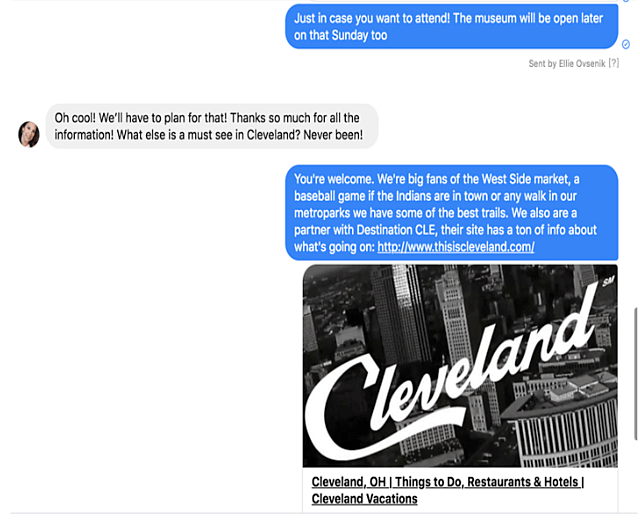
Since the Messenger launch, they claim to have raised their audience size by 81% and sales from prospects by 12%. The company claims that this feature was so successful that they even received 54 messages on an Easter Sunday.
Takeaways
Being available to connect with your audiences through Messenger can be beneficial to your business and your brand. While the Rock & Roll Hall of Fame boosted purchases, they also got to interact with their audiences on a personal level. Their availability might have made them look like a more trustworthy, friendly brand that was actually interested in their fanbase rather than just sales.
Facebook Reach Case Study:
Buffer
In early 2016, Buffer started to see a decline in their brand reach and engagement on Facebook due to algorithm changes that favored individuals rather than brands. In an effort to prevent their engagement and reach numbers from dropping even further.
The brand decided to cut their posting frequency by 50%. With less time focused on many posts, they could focus more time on creating fewer, better-quality posts that purely aimed at gaining engagement. For example, instead of posting standard links and quick captions, they began to experiment with different formats such as posts with multi-paragraph captions and videos. After starting the strategy in 2016, they continued it through 2018.
Here’s an example of one an interview that was produced and shared exclusively on Facebook.
The Results: By 2018, Buffer claimed that the average weekly reach nearly tripled from 44,000 at the beginning of the experiment to 120,000. The page’s average daily engagements also doubled from roughly 500 per day to around 1,000.
In 2018, Buffer claimed that their posts reached between 5,000 to 20,000 people, while posts from before the experiment reached less than 2,000.
Although Buffer began the experiment before major Facebook algorithm changes, they updated this case study in 2018 claiming that this strategy has endured platform shifts and is still providing them with high reach and engagement.
Takeaways
It can be easy to overpost on a social network and just hope it works. But constant posts that get no reach or engagement could be wasted your time and money. They might even make your page look desperate.
What Buffer found was that less is more. Rather than spending your time posting whatever you can, you should take time to brainstorm and schedule out interesting posts that speak directly to your customer.
Facebook Video Views Case Studies:
Tomcat
Gearing up for Halloween in 2016, Tomcat, a rodent extermination company, wanted to experiment with a puppet-filled, horror-themed, live video event. The narrative, which was created in part by their marketing agency, told the story of a few oblivious teenage mice that were vacationing in a haunted cabin in the woods. At peak points of the story, audiences were asked to use the comments to choose which mouse puppet would die next or how they would die.
Prior to the video event, Tomcat also rolled out movie posters with the event date, an image of the scared mouse puppets, and a headline saying, “Spoiler: They all die!”
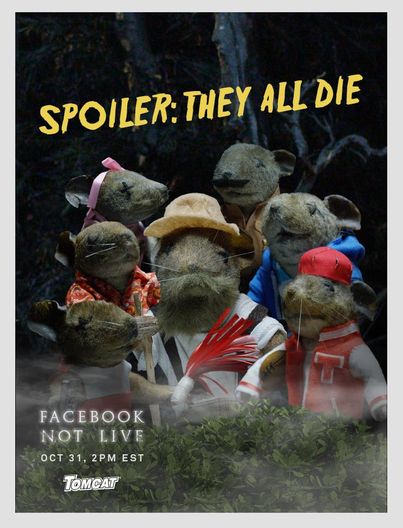
Results: It turns out that a lot of people enjoy killing rodents. The live video got over 2.3 million unique views, and 21% of them actively participated. As an added bonus, the video also boosted Tomcat’s Facebook fanbase by 58% and earned them a Cyber Lion at the 2017 Cannes Lions awards.
Here’s a hilarious sizzle reel that shows a few clips from the video and a few key stats:
Takeaways
This example shows how creative content marketing can help even the most logistical businesses gain engagement. While pest control can be a dry topic for a video, the brand highlighted it in a creative and funny way.
This study also highlights how interactivity can provide huge bonuses when it comes to views and engagement. Even though many of the viewers knew all the rats would die, many still participated just because it was fun.
Not only might this peak brand interest from people who hadn’t thought that deeply about pest control, but interactivity can also help a video algorithmically. As more people comment, share, and react to a live video, there’s more likelihood that it will get prioritized and displayed in the feeds of others.
HubSpot
In 2017, HubSpot’s social media team embarked on an experiment where they pivoted their video goals from lead generation to audience engagement. Prior to this shift, HubSpot had regularly posted Facebook videos that were created to generate leads. As part of the new strategy, the team brainstormed a list of headlines and topics that they thought their social media audience would actually like, rather than just topics that would generate sales.
Along with this pivot, they also experimented with other video elements including video design, formatting, and size.
Results: After they started to launch the audience-friendly videos, they saw monthly video views jump from 50,000 to 1 million in mid-2017.
Takeaways
Creating content that caters to your fanbase’s interests and the social platform it’s posted on can be much more effective than content that seeks out leads.
While videos with the pure goal of selling a product can fall flat with views and engagement, creative videos that intrigue and inform your audiences about a topic they relate to can be a much more effective way to gain and keep your audience. Once the audience trusts you and consumes your content regularly, they might even trust and gain interest in your products.
Facebook App Installs Case Study:
FoxNext Games
FoxNext Games, a video game company owned by 20th Century Fox, wanted to improve the level of app installs for one of its newest releases, Marvel Strike Force. While FoxNext had previously advertised other games with Facebook video ads, they wanted to test out the swipe-able photo carousel post format. Each photo, designed like a playing card, highlighted a different element of the game.
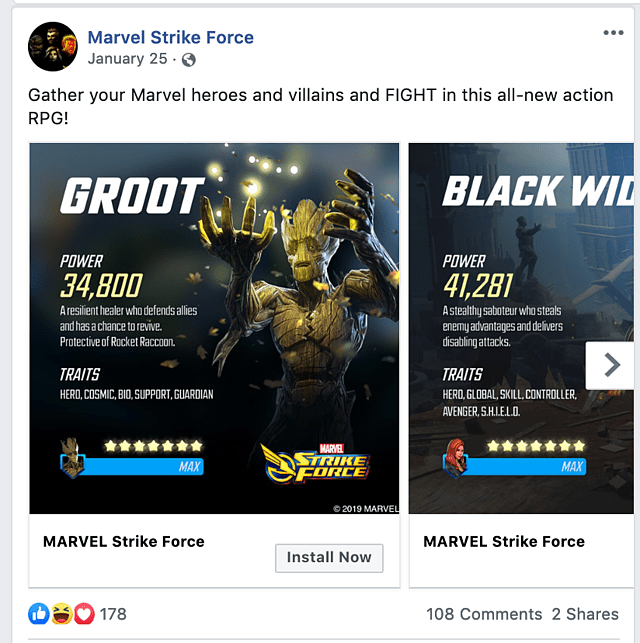
The add offered a call-to-action button that said “Install Now” and lead to the app store where it could be downloaded. FoxNext launched it on both Facebook and Instagram. To see if the carousel was more efficient than video campaigns, they compared two ads that advertised the same game with each format.
Results: According to Facebook, the photo ads delivered a 6% higher return on ad spend, 14% more revenue, 61% more installs, and 33% lower cost per app install.
Takeaways
If your product is visual, a carousel can be a great way to show off different elements of it. This case study also shows how designing ads around your audience’s interest can help each post stand out to them. In this scenario, FoxNext needed to advertise a game about superheroes. They knew that their fanbase was interested in gaming, adventure, and comic books, so they created carousels that felt more like playing cards to expand on the game’s visual narrative.
Facebook Lead Gen Case Study:
Major Impact Media
In 2019, Major Impact Media released a case study about a real-estate client that wanted to generate more leads. Prior to working with Major Impact, the Minneapolis, Minnesota brokerage hired another firm to build out an online lead generation funnel that had garnered them no leads in the two months it was active. They turned to Major Impact looking for a process where they could regularly be generating online leads.
As part of the lead generation process, the marketing and brokerage firms made a series of Facebook ads with the lead generation objective set. Major Impact also helped the company build a CRM that could capture these leads as they came in.
Results: Within a day, they received eight leads for $2.45 each. In the next 90 days, the marketing firm claimed the ads generated over 370 local leads at the average cost of $6.77 each. Each lead gave the company their name, email, and phone number.
Although these results sound like a promising improvement, readers of this case study should keep in mind that no number of qualified leads or ROI was disclosed. While the study states that leads were gained, it’s unclear which of them lead to actual sales — if any.
Takeaways
This shows how Facebook ad targeting can be helpful when you’re seeking out leads from a specific audience in a local area. The Minneapolis brokerage’s original marketing and social media strategies weren’t succeeding because they were looking for a very specific audience of prospective buyers in the immediate area.
Ad targeting allowed their posts to be placed on the news feeds of people in the area who might be searching for real estate or have interests related to buying a home. This, in turn, might have caused them more success in gaining leads.
Facebook Engagement Case Study:
Hawkers
When the eyewear brand Hawkers partnered up with Spanish clothing brand El Ganso for a joint line of sunglasses, Hawkers’ marketing team wanted to see which Facebook ad format would garner the most engagement. Between March and April of 2017, they launched a combination of standard ads and collection ads on Facebook.
While their standard ads had a photo, a caption and a call-to-action linking to their site, the collection ads offered a header image or video, followed by smaller images of sunglasses from the line underneath.
To A/B test ad effectiveness of the different ad types, Hawkers showed half of its audience standard photo ads while the other half were presented with the collection format. The company also used Facebook’s Audience Lookalike feature to target the ads their audiences and similar users in Spain.
Results: The collection ad boosted engagement by 86%. The collection ads also saw a 51% higher rate of return than the other ads.
Takeaways
This study shows how an ad that shows off different elements of your product or service could be more engaging to your audience. With collection ads, audiences can see a bunch of products as well as a main image or video about the sunglass line. With a standard single photo or video, the number of products you show might be limited. While some users might not respond well to one image or video, they might engage if they see a number of different products or styles they like.
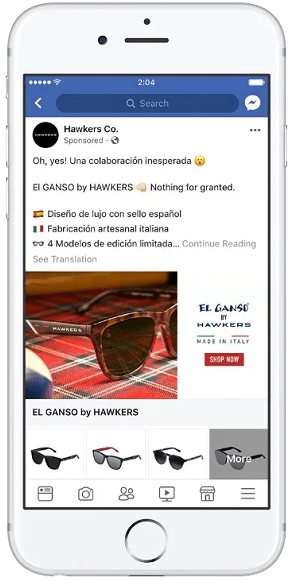
Facebook Conversion Case Study:
Femibion from Merck
Femibion, a German family-planning brand owned by Merck Consumer Health, wanted to generate leads by offering audiences a free baby planning book called “Femibion BabyPlanung.” The company worked with Facebook to launch a multistage campaign with a combination of traditional image and link ads with carousel ads.
The campaign began with a cheeky series of carousel ads that featured tasteful pictures of “baby-making places,” or locations where women might conceive a child. The later ads were a more standard format that displayed an image of the book and a call-to-action.
When the first ads launched in December 2016, they were targeted to female audiences in Germany. In 2017, during the later stages of the campaign, the standard ads were retargeted to women who had previously interacted with the carousel ads. With this strategy, people who already showed interest would see more ads for the free product offer. This could cause them to remember the offer or click when they saw it a second time.
Results: By the time the promotion ended in April 2017, ads saw a 35% increase in conversion rate. The company had also generated 10,000 leads and decreased their sample distribution cost by two times.
Takeaways
This case study shows how a company successfully brought leads through the funnel. By targeting women in Germany for their first series of creative “baby-making” ads, they gained attention from a broad audience. Then, by focusing their next round of ads on women who’d already shown some type of interest in their product, they reminded those audiences of the offer which may have enabled those people to convert to leads.
Facebook Product Sales Case Study
Samsung
In an effort to boost sales from its Latin American audiences, Samsung promoted the 2015 Argentina launch of the Galaxy S6 smartphone with a one-month Facebook campaign.
The campaign featured three videos that highlighted the phone’s design, camera, and long battery life respectively.
One video was released each week and all of them were targeted to men and women in Argentina. In the fourth week of the campaign, Samsung launched more traditional video and photo ads about the product. These ads were specifically targeted to people who’d engaged with the videos and their lookalike audiences.
Results: Samsung received 500% ROI from the month-long campaign and a 7% increase in new customers.
Takeaways
Like Femibion, Samsung tested a multiple ad strategy where the targeting got more specific as the promotions continued. They too saw the benefit of targeting ads to users who already showed interest in the first rounds of advertisements. This strategy definitely seems like one that could be effective when trying to gain more qualified leads.
Facebook Store Visits Case Study:
Church's Chicken
The world’s third-largest chicken restaurant, Church’s Chicken, wanted to see if they could use Facebook to increase in-restaurant traffic. From February to October of 2017, the chain ran a series of ads with the “Store Traffic” ad objectives. Rather than giving customers a link to a purchasing or order page, these ads offer users a call-to-action that says “Get Directions.” The dynamic store-traffic ad also gives users the store information for the restaurant closest to them.

The ads ran on desktop and mobile newsfeeds and were targeted at people living near a Church’s Chicken who were also interested in “quick-serve restaurants.” The study also noted that third-party data was used to target customers who were “big spenders” at these types of restaurants.
To measure the results, the team compared data from Facebook’s store-reporting feature with data from all of its locations.
Results: The ads resulted in over 592,000 store visits with an 800% ROI. Each visit cost the company an average of $1.14. The ROI of the campaign was four times the team’s return goal.
Takeaways
If you don’t have an ecommerce business, Facebook ads can still be helpful for you if they’re strategized properly. In this example, Church’s ads targeted locals who like quick-serve restaurants and served them a dynamic ad with text that notified them of a restaurant in their direct area. This type of targeting and ad strategy could be helpful to small businesses or hyperlocal businesses that want to gain foot traffic or awareness from the prospective customers closest to them.
Navigating Case Studies
If you’re a marketer that wants to execute proven Facebook strategies, case studies will be incredibly helpful for you. If the case studies on the list above didn’t answer one of your burning Facebook questions, there are plenty of other resources and success stories online.
As you look for a great case study to model your next campaign strategy, look for stories that seem credible and don’t feel too vague. The best case studies will clearly go over a company’s mission, challenge or mission, process, and results.
Because many of the case studies you’ll find are from big businesses, you might also want to look at strategies that you can implement on a smaller scale. For example, while you may not be able to create a full commercial at the production quality of Pandora, you might still be able to make a lower-budget video that still conveys a strong message to your audience.
If you’re interested in starting a paid campaign, check out this helpful how-to post. If you just want to take advantage of free options, we also have some great information on Facebook Live and Facebook for Business.
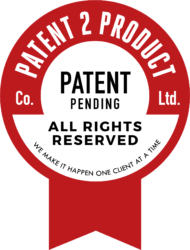
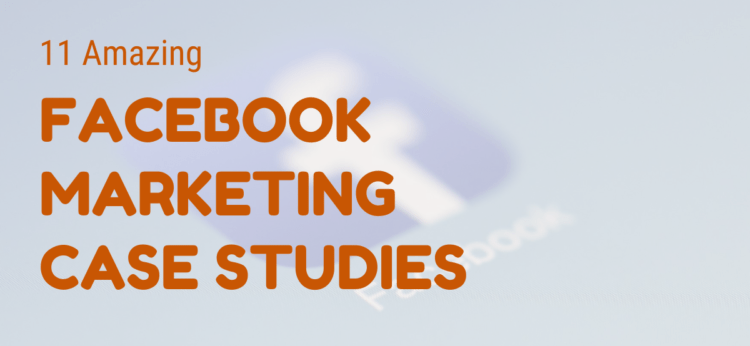

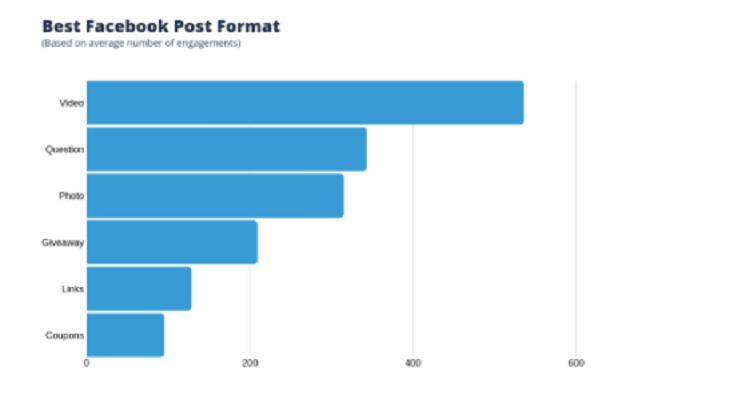
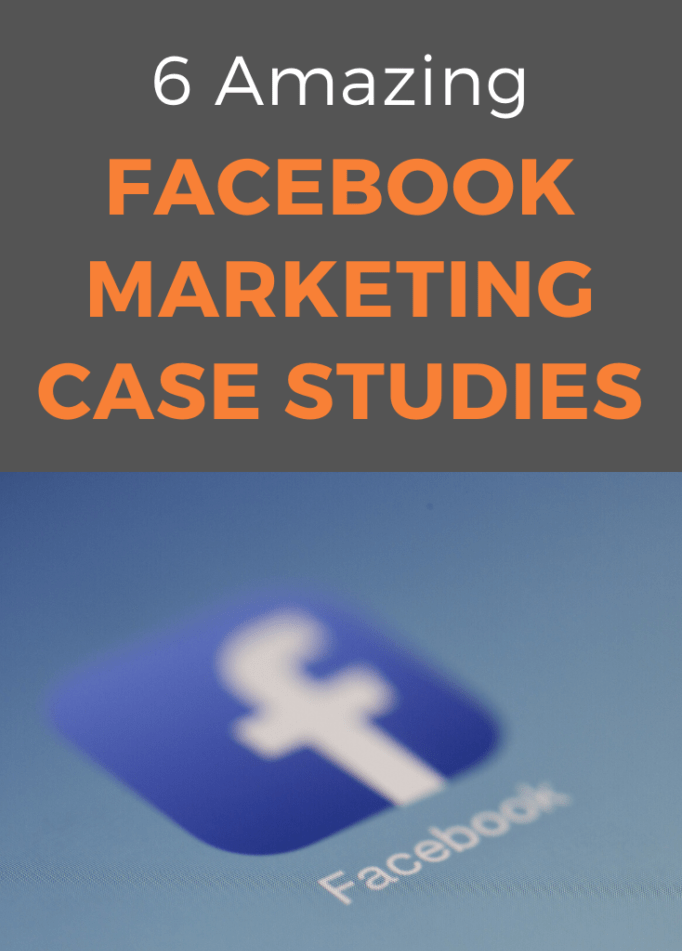
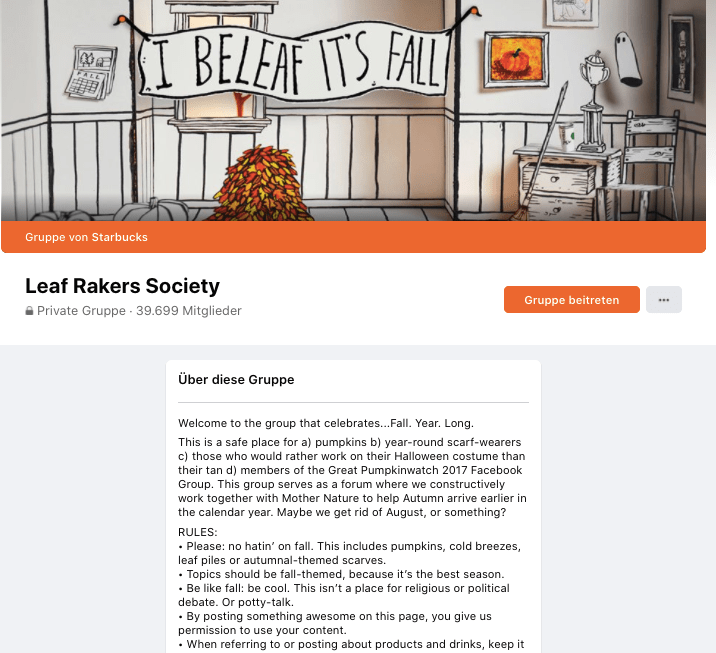
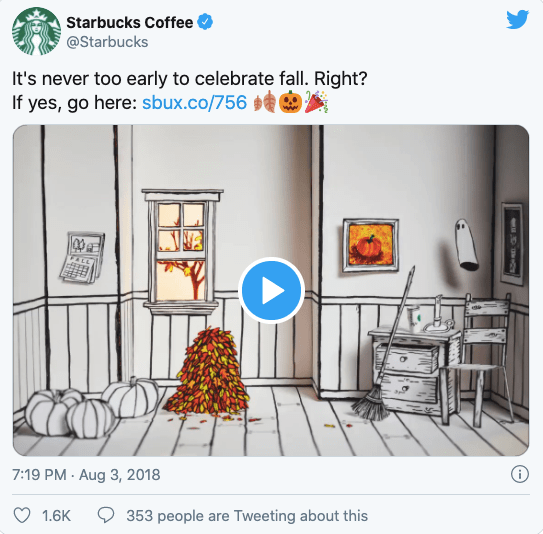
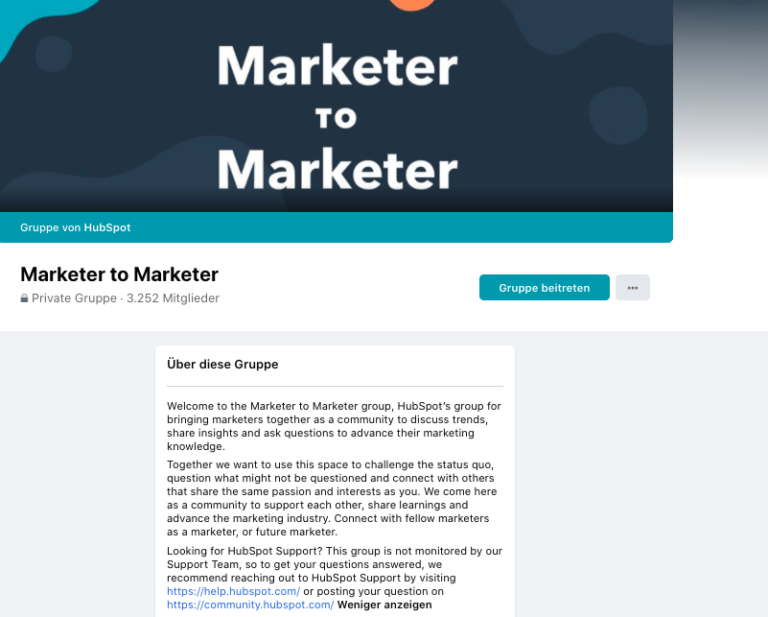


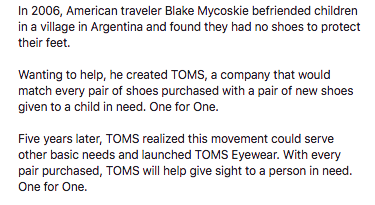 This strategy gives a lot of possibilities for stories to tell – each product in itself is a call-to-action to do something good. And this type of marketing campaign works on Facebook. They can announce new partnerships and products – people will like them and allow leveraging the good deed that is always included.
This strategy gives a lot of possibilities for stories to tell – each product in itself is a call-to-action to do something good. And this type of marketing campaign works on Facebook. They can announce new partnerships and products – people will like them and allow leveraging the good deed that is always included. 